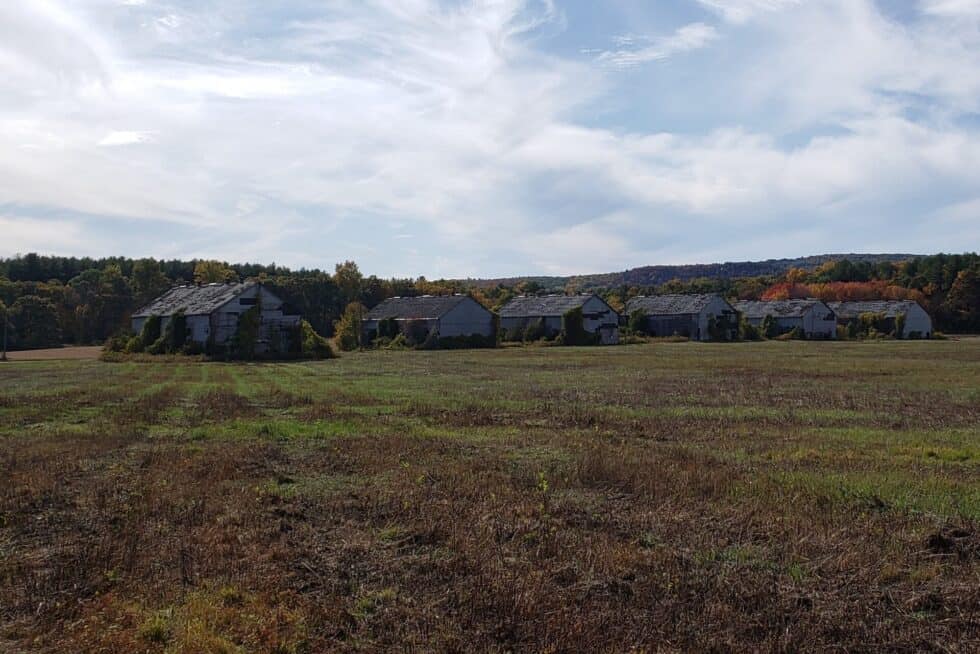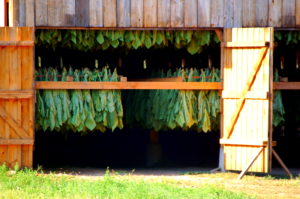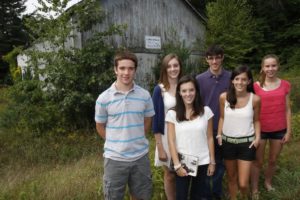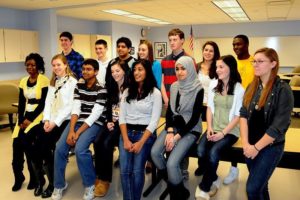By Richard Curtiss
(c) Connecticut Explored Inc., Winter 2022-23
Subscribe/Buy the Issue!
 In the summer of 1944 the Farmington Valley was alive with the sights and sounds of a thriving tobacco industry. Clouds of dust filled the sky as trucks and tractors shuttled equipment and people in all directions. Workers busily planted young tobacco plants beneath a sea of white cheesecloth netting. The cathedral-like barns, which sat empty all winter, would soon be filled to the rafters with shade tobacco, a variety used to wrap cigars and favored by cigar makers and smokers alike.
In the summer of 1944 the Farmington Valley was alive with the sights and sounds of a thriving tobacco industry. Clouds of dust filled the sky as trucks and tractors shuttled equipment and people in all directions. Workers busily planted young tobacco plants beneath a sea of white cheesecloth netting. The cathedral-like barns, which sat empty all winter, would soon be filled to the rafters with shade tobacco, a variety used to wrap cigars and favored by cigar makers and smokers alike.
 Growing and harvesting tobacco on this scale required a significant labor force. As the Hartford Courant reported on December 15, 1942, tobacco was added to the list of crops “essential” for the war effort. It was more important than ever for Connecticut tobacco companies to find a steady supply of workers. As in previous summers, high-school girls from Pennsylvania and Florida, African-American men from Southern high schools and universities, and workers from the Caribbean arrived daily to fill the ranks on the farms. One of those new arrivals in the summer of 1944 was a young Martin Luther King Jr. Although only 15, King had just been admitted to Morehouse College in Atlanta, Georgia, through a wartime program designed to attract younger students. For the next three months King and his fellow students would reside at what their college newspaper, The Maroon Tiger, would refer to as “Camp Simsbury,” a recently constructed three-story dorm built by Cullman Bros., Inc. Before the1990s most of KIng’s biographers had devoted relatively little space to his time in Connecticut, and documentation of that time was sparse. That changed in 1992 when Stanford University published the first volume ofThe Papers of Martin Luther King, Jr., edited by Clayborne Carson, Ralph Luker, and Penny A. Russell (University of California Press, 1992). Included in the collection were five letters, previously unavailable to scholars, that had recently been shared with Stanford by King’s sister Christine King Farris. The five short letters, written in the summer of 1944 by King to his parents, offer tantalizing clues about King’s time in Connecticut and the influence that the experience may have had on him. In his letters, KIng notes that this was his first extended time away from home and his first trip outside of the segregated South. He also describes attending services in an integrated church and his role as the religious leader in his dorm in Simsbury.
Growing and harvesting tobacco on this scale required a significant labor force. As the Hartford Courant reported on December 15, 1942, tobacco was added to the list of crops “essential” for the war effort. It was more important than ever for Connecticut tobacco companies to find a steady supply of workers. As in previous summers, high-school girls from Pennsylvania and Florida, African-American men from Southern high schools and universities, and workers from the Caribbean arrived daily to fill the ranks on the farms. One of those new arrivals in the summer of 1944 was a young Martin Luther King Jr. Although only 15, King had just been admitted to Morehouse College in Atlanta, Georgia, through a wartime program designed to attract younger students. For the next three months King and his fellow students would reside at what their college newspaper, The Maroon Tiger, would refer to as “Camp Simsbury,” a recently constructed three-story dorm built by Cullman Bros., Inc. Before the1990s most of KIng’s biographers had devoted relatively little space to his time in Connecticut, and documentation of that time was sparse. That changed in 1992 when Stanford University published the first volume ofThe Papers of Martin Luther King, Jr., edited by Clayborne Carson, Ralph Luker, and Penny A. Russell (University of California Press, 1992). Included in the collection were five letters, previously unavailable to scholars, that had recently been shared with Stanford by King’s sister Christine King Farris. The five short letters, written in the summer of 1944 by King to his parents, offer tantalizing clues about King’s time in Connecticut and the influence that the experience may have had on him. In his letters, KIng notes that this was his first extended time away from home and his first trip outside of the segregated South. He also describes attending services in an integrated church and his role as the religious leader in his dorm in Simsbury.
 The letters and the interesting questions they raised became a launching point for students at Simsbury High School to begin an inquiry-based research project in the summer of 2010. In partnership with the Simsbury Free Library and under the guidance of Tara Willerup, T.J. Donohue, and Jim Flynn, the students set out to paint a more complete picture of King’s time in Connecticut. The 16 students conducting the initial research were divided into teams, each with a specific research focus: What brought King to Connecticut? What did he do while he was here? What effect, if any, did his time in Connecticut have on him? The project required students to view history through a variety of lenses – political, social and economic.Students also were required to conduct both archival research and oral-history interviews. The bulk of the archival research took place at the Luddy/Taylor Connecticut Valley Tobacco Museum in Windsor and the Simsbury Free Library. Oral-history interviews were conducted at Shiloh Baptist Church in Hartford and at various residences in Simsbury. One of the highlights was an interview with Reverend King T. Hayes of Hartford in which he recounted his own experiences working in Simsbury’s tobacco fields in the summer after King was there. Another of those interviewed was a 104-year-old Simsbury resident with memories of attending church services with the Morehouse students at the Congregational church in town.
The letters and the interesting questions they raised became a launching point for students at Simsbury High School to begin an inquiry-based research project in the summer of 2010. In partnership with the Simsbury Free Library and under the guidance of Tara Willerup, T.J. Donohue, and Jim Flynn, the students set out to paint a more complete picture of King’s time in Connecticut. The 16 students conducting the initial research were divided into teams, each with a specific research focus: What brought King to Connecticut? What did he do while he was here? What effect, if any, did his time in Connecticut have on him? The project required students to view history through a variety of lenses – political, social and economic.Students also were required to conduct both archival research and oral-history interviews. The bulk of the archival research took place at the Luddy/Taylor Connecticut Valley Tobacco Museum in Windsor and the Simsbury Free Library. Oral-history interviews were conducted at Shiloh Baptist Church in Hartford and at various residences in Simsbury. One of the highlights was an interview with Reverend King T. Hayes of Hartford in which he recounted his own experiences working in Simsbury’s tobacco fields in the summer after King was there. Another of those interviewed was a 104-year-old Simsbury resident with memories of attending church services with the Morehouse students at the Congregational church in town.
 There were a number of exciting finds along the way. For example, the team located an audio recording of a speech King delivered in May 1959 as part of the University of Hartford’s Alexander S. Keller lecture series. In his address, “The Future of Integration,” King specifically mentions working in Simsbury as a young man. It’s the only known audio recording where he mentions his time working in the state. Another important discovery was the connection between King’s time in Connecticut and his later decision to join the ministry. On his 1948 application to Crozer Theological Seminary in Chester, Pennsylvania, King states that his call to join the ministry occurred during the summer of 1944 when he “felt an inescapable urge to serve society.”
There were a number of exciting finds along the way. For example, the team located an audio recording of a speech King delivered in May 1959 as part of the University of Hartford’s Alexander S. Keller lecture series. In his address, “The Future of Integration,” King specifically mentions working in Simsbury as a young man. It’s the only known audio recording where he mentions his time working in the state. Another important discovery was the connection between King’s time in Connecticut and his later decision to join the ministry. On his 1948 application to Crozer Theological Seminary in Chester, Pennsylvania, King states that his call to join the ministry occurred during the summer of 1944 when he “felt an inescapable urge to serve society.”
The students compiled and presented their research in a short documentary film entitled Summers of Freedom. The film received national attention and was featured on the CBS Evening News in January 2011. Immediately after completing their work on the documentary the students launched a fundraising campaign to build a permanent memorial to Dr. King in Simsbury. The group made presentations to charitable boards at local corporations and solicited donations from individuals. After a successful multi-year fundraising campaign, a student-designed memorial was built and unveiled to the public in 2021. The memorial, located in the center of Simsbury on the grounds of the Simsbury Free Library, has recently been added to the Connecticut Freedom Trail.
Students currently are working on program and event ideas in an effort to share Dr. King’s legacy with the greater community. In July the group was proud to host its first field trip, welcoming students from Hartford’s Discovering Life Skills Creatively program for a viewing of the documentary, a tour of the memorial, and a fun day of interactive programming. This type of civic engagement is an important part of a high-school education and is a point of emphasis in the State of Connecticut’s new capstone graduation requirement in which students are encouraged to “apply the knowledge and skills that they have acquired during their K-12 education in an authentic and self-directed way.”
Richard Curtiss is the chair of the Social Studies/History Department at Simsbury High School and served as the faculty advisor for the project.
